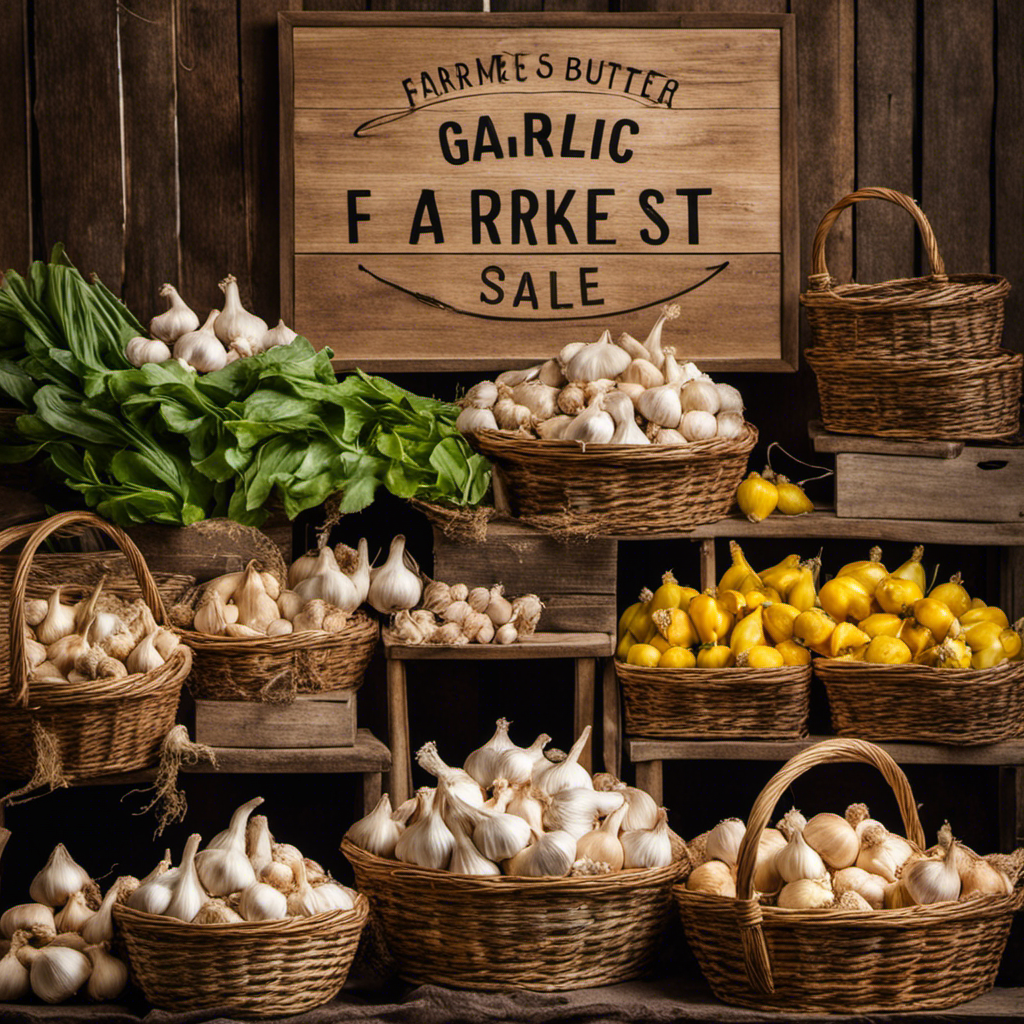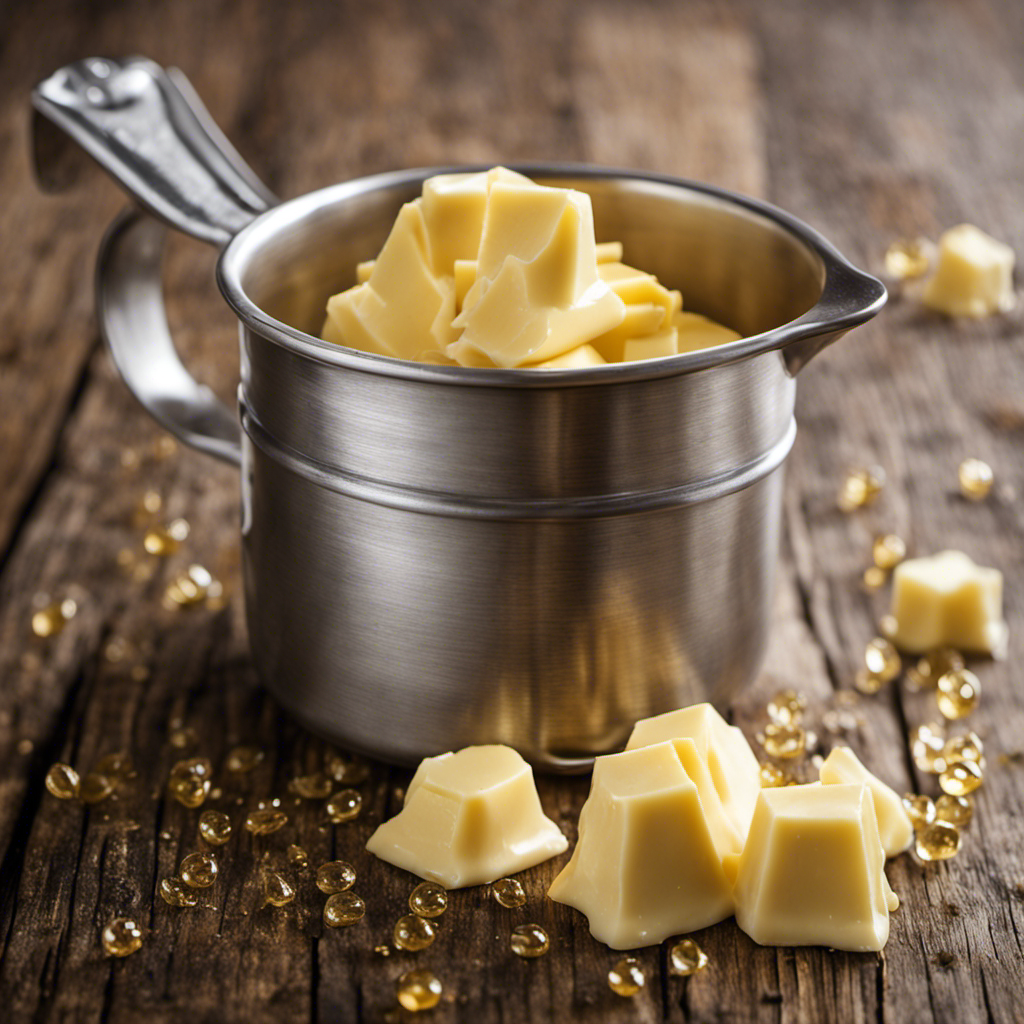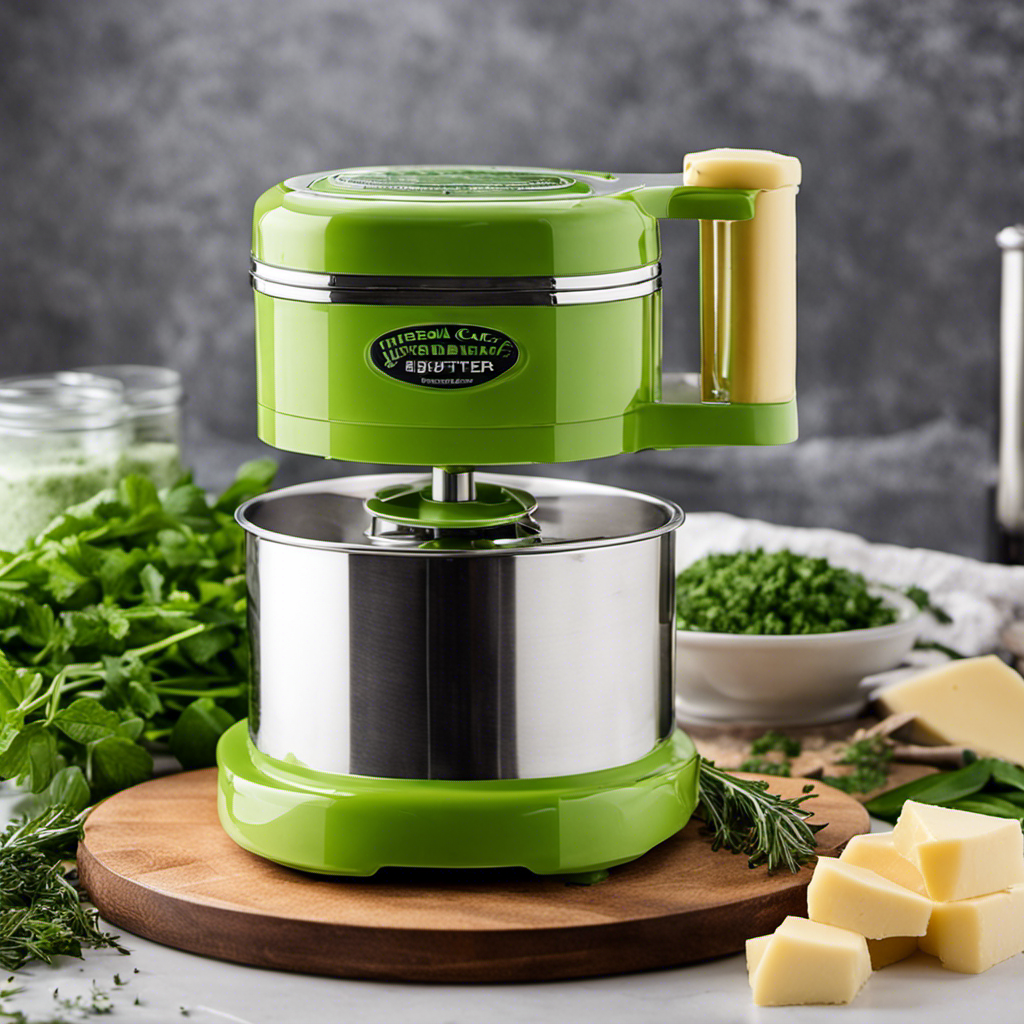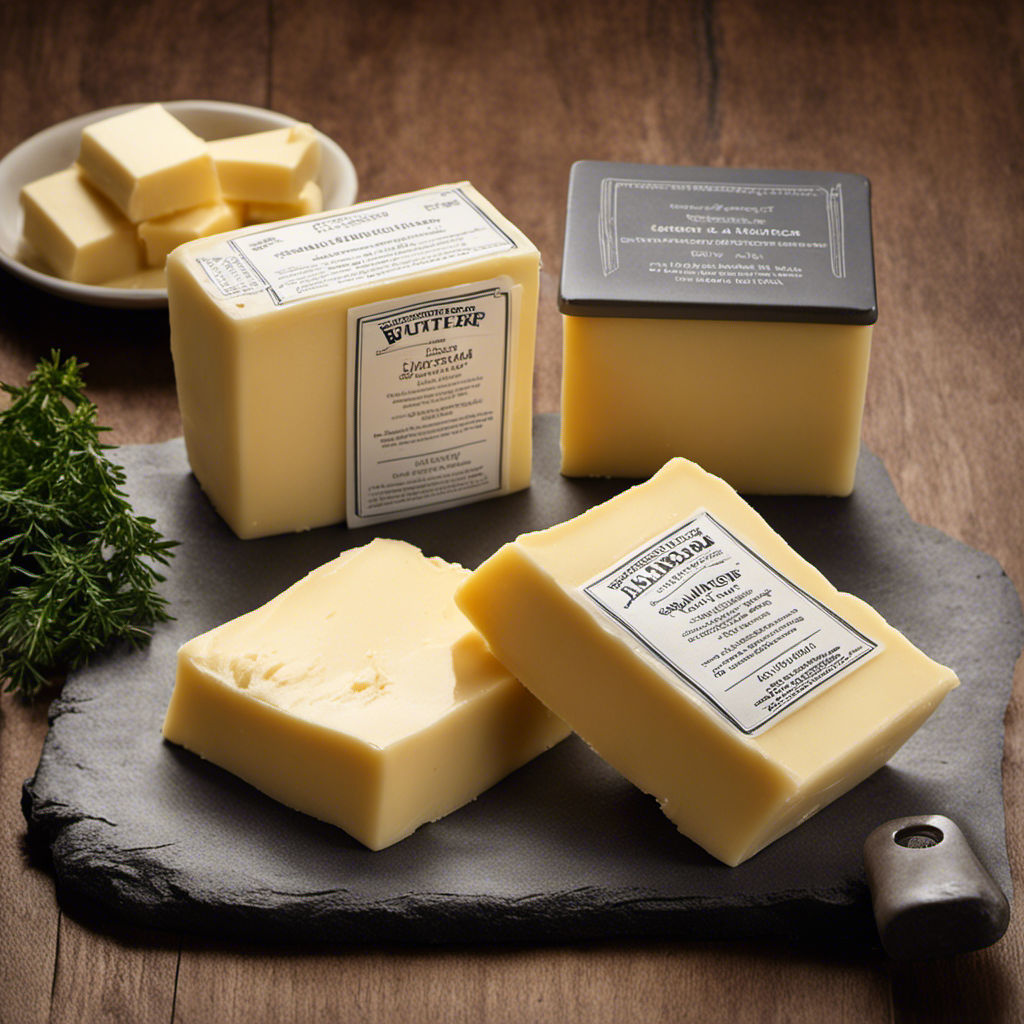Were you aware that garlic butter, aside from being scrumptious, also offers immense versatility in cooking? Its deep and savory taste has the power to enhance the quality of any meal, taking it up a notch.
If you’re wondering where to buy garlic butter, look no further! In this article, I’ll share with you the best places to find this delectable condiment.
From local grocery stores to online marketplaces, specialty food shops to farmers’ markets, there are plenty of options to satisfy your garlic butter cravings.
Let’s dive in and explore the wonderful world of garlic butter shopping!
Key Takeaways
- Local grocery stores, online marketplaces, specialty food shops, farmers’ markets, gourmet food stores, bulk food suppliers, and health food stores are all places where garlic butter can be purchased.
- Buying locally supports the local economy, ensures fresh and high-quality products, provides personalized service and valuable insights from local farmers, supports sustainable farming practices, stimulates the local economy, and creates a community connection and sense of togetherness.
- There is a wide variety and selection of garlic butter available, sourced from local farmers and international brands, with options made from locally sourced ingredients, and a range of flavors and brands to explore, including unique options not found elsewhere, infused flavors, and artisanal blends.
- Buying garlic butter online offers convenience and saves time and effort with doorstep delivery, customer reviews provide insights before making a purchase, there is a unique shopping experience connecting with growers and producers, and farmers’ markets provide local vendors selling garlic butter, including organic options.
Local Grocery Stores
You can find garlic butter at local grocery stores. These stores are a convenient option for purchasing this delicious spread.
Local grocery stores often carry a variety of garlic butter options, sourced both from local farmers and international brands. This ensures that you have a wide selection to choose from.
When it comes to supporting local farmers, some grocery stores prioritize carrying garlic butter made from locally sourced ingredients. This not only supports the local economy but also ensures that you are getting a fresh and high-quality product.
On the other hand, if you prefer to explore international brands, you can find garlic butter from renowned companies that specialize in creating delectable spreads.
Online Marketplaces
When browsing online marketplaces, it’s easy to find a variety of options for purchasing deliciously flavored spreads. Whether you’re looking for garlic butter made by local farmers or international brands, these platforms have got you covered.
Supporting local farmers is a great way to ensure the freshness and quality of the product you’re buying. Many online marketplaces offer a wide range of spreads made by local farmers, allowing you to directly support their businesses.
On the other hand, if you’re looking for a wider selection and want to try out different garlic butter flavors from around the world, international brands are also available. These brands often bring unique and exotic flavors to the table, providing a global culinary experience right at your fingertips.
Specialty Food Shops
When it comes to finding the best garlic butter, there are two main options to consider: buying locally or purchasing online. Each option has its own advantages and drawbacks, so it’s important to weigh them carefully.
Additionally, the flavor profiles of garlic butter can vary greatly depending on the ingredients and preparation methods used, so it’s worth exploring different options to find your preferred taste.
Lastly, specialty food shops often offer unique garlic butter options that you won’t find elsewhere, such as infused flavors or artisanal blends, making them a great choice for those seeking something out of the ordinary.
Local Vs. Online
There’s a difference between buying garlic butter locally and online. When it comes to purchasing garlic butter, there are a few key factors to consider.
Here are three reasons why buying garlic butter from local farmers is a great option:
- Freshness: Local farmers often grow their own garlic and make their own butter, ensuring that the ingredients are fresh and of high quality.
- Support for local economy: By purchasing from local farmers, you are supporting your community and helping to sustain local businesses.
- Personalized service: Local farmers are often passionate about their products and can provide valuable insights and recommendations based on their expertise.
On the other hand, here are three reasons why buying garlic butter online can be advantageous:
- Convenience: With just a few clicks, you can have garlic butter delivered to your doorstep, saving you time and effort.
- Wide selection: Online retailers often offer a wider variety of garlic butter options, allowing you to explore different flavors and brands.
- Customer reviews: Online platforms provide customer reviews, giving you the opportunity to read about others’ experiences with the product before making a purchase.
Best Flavor Profiles
If you’re looking for a burst of tangy flavor, the lemon garlic butter is a must-try.
This delightful combination of zesty lemon and savory garlic creates a harmonious balance that enhances the taste of any dish.
The tanginess of the lemon adds a refreshing and slightly acidic note, while the garlic brings a robust and aromatic quality.
These flavors pair exceptionally well with seafood, such as grilled shrimp or pan-seared salmon.
The lemon garlic butter also works wonders when used as a marinade for chicken or tossed with freshly cooked pasta.
When cooking, simply melt a dollop of this butter in a pan and let it infuse your dish with its irresistible tanginess and richness.
Unique Garlic Butter Options
For a truly unique twist on your usual butter options, you’ve got to try these creative garlic-infused spreads. Garlic butter recipes have been a staple in many cuisines around the world for centuries. The aromatic and savory combination of garlic and butter adds a burst of flavor to any dish.
Here are three sub-lists of garlic butter options that are sure to elevate your culinary creations:
-
Classic Garlic Butter:
-
Made with fresh garlic cloves and unsalted butter
-
Perfect for spreading on bread or melting over grilled meats
-
Adds a rich and garlicky taste to pasta dishes
-
Herb-infused Garlic Butter:
-
Incorporates fragrant herbs like parsley, thyme, or rosemary
-
Ideal for basting roasted vegetables or marinating chicken
-
Provides a refreshing and aromatic twist to your recipes
-
Spicy Garlic Butter:
-
Infused with red chili flakes or hot sauce for a kick of heat
-
Enhances the flavor of seafood, such as shrimp or lobster
-
Adds a spicy and bold element to your favorite dishes
Garlic butter is not only a versatile ingredient, but it also holds a prominent place in international cuisine. From French escargot to Italian garlic bread and Indian garlic naan, garlic butter is used in various ways across the globe.
Farmers’ Markets
When it comes to finding fresh produce options and supporting small businesses, farmers’ markets are the way to go.
These vibrant marketplaces offer a wide variety of locally sourced fruits, vegetables, and other food products, ensuring that you have access to the freshest and highest quality ingredients.
Not only do farmers’ markets provide an opportunity to support local vendors and stimulate the local economy, but they also offer a unique shopping experience that allows you to connect directly with the people who grow and produce your food.
Local Vendors’ Availability
You can find local vendors who sell garlic butter at the farmer’s market. These vendors are usually local farmers who have their own garlic farms and make their own butter. It’s a great way to support local agriculture and get fresh, high-quality garlic butter.
Here are some reasons why buying garlic butter from local vendors at the farmer’s market is a great choice:
-
Local farmers: By purchasing garlic butter from local vendors, you are directly supporting local farmers and their businesses. This helps to strengthen the local economy and promote sustainable farming practices.
-
Organic options: Many local vendors at the farmer’s market offer organic garlic butter. This means that the garlic used to make the butter is grown without the use of synthetic pesticides or fertilizers. It’s a healthier option for you and the environment.
-
Freshness and quality: Since the garlic butter is made by the vendors themselves, you can be assured of its freshness and quality. It’s made in small batches with care and attention to detail, resulting in a delicious and flavorful product.
Fresh Produce Options
If you’re looking for fresh produce options, head over to the farmer’s market. It’s the perfect place to find a wide variety of locally grown fruits and vegetables. Not only will you be able to support small businesses, but you’ll also be getting the freshest and most flavorful produce available.
At the farmer’s market, you can find everything from crisp apples and juicy oranges to leafy greens and vibrant tomatoes. The selection is always changing with the seasons, so you’ll never get bored with the options. Plus, you can chat with the farmers themselves and learn about their growing practices.
Supporting Small Businesses
Visiting the farmer’s market is a great way to support small businesses and discover unique, locally grown produce. Not only does it provide an opportunity to connect with the community and foster a sense of togetherness, but it also has a significant economic impact.
When you shop at the farmer’s market, you are directly supporting local farmers and artisans, allowing them to continue doing what they love and contribute to the local economy. The community support extends beyond just purchasing goods; it creates a sense of camaraderie among vendors and customers alike.
Additionally, the economic impact of shopping at the farmer’s market goes beyond the immediate transaction. It helps sustain the local agricultural industry, promotes sustainable farming practices, and reduces the carbon footprint associated with transporting produce long distances.
Transitioning to gourmet food stores, you can find an array of specialty items that cater to discerning palates.
Gourmet Food Stores
When looking for gourmet food stores, check out the specialty shops in your area for a wide selection of garlic butter options. These stores often source their ingredients from local farmers, ensuring freshness and supporting the community. You’ll find garlic butter made from locally grown garlic, giving it a unique and vibrant flavor.
Additionally, gourmet food stores often offer international imports, bringing you garlic butter from different parts of the world. From the rich and creamy French garlic butter to the spicy and aromatic Indian varieties, there’s something for every palate.
These specialty shops take pride in curating a diverse range of garlic butter options, allowing you to explore different flavors and culinary traditions.
If you’re looking to buy garlic butter in bulk, let’s now transition to the next section about bulk food suppliers.
Bulk Food Suppliers
Looking to stock up on your favorite gourmet ingredients? Check out the bulk food suppliers in your area for a wide variety of options to choose from. These suppliers offer a range of unique garlic butter options that are perfect for adding flavor to your dishes.
Here are some reasons why buying from bulk food suppliers is a great idea:
-
Quality: Bulk food suppliers often source their ingredients from reputable farms and producers, ensuring that you get the highest quality products.
-
Variety: These suppliers offer a wide selection of garlic butter options, from traditional flavors to more adventurous ones like roasted garlic or truffle-infused butter.
-
Cost-effective: Buying in bulk allows you to save money compared to purchasing smaller quantities from regular grocery stores.
Health Food Stores
If you’re trying to eat healthier, health food stores are a great place to find a wide variety of nutritious options. These stores specialize in offering products that are high in health food benefits, making it easier for consumers to make healthier choices.
From organic produce to gluten-free snacks and dairy alternatives, health food stores cater to a range of dietary needs and preferences.
One of the best things about shopping at a health food store is the abundance of recipe ideas and uses for various ingredients. They often provide recipe cards or online resources that share creative ways to incorporate nutritious foods into your meals.
With a little creativity and guidance, you can transform simple ingredients into delicious and healthy dishes.
Transitioning into the next section about homemade options, let’s explore how you can make your own nutritious meals and snacks at home.
Homemade Options
When it comes to garlic butter, sometimes the best option is to make it yourself. Homemade alternatives allow you to control the ingredients and customize the flavor to your liking.
Here are some flavor variations and ideas to try:
-
Classic Garlic Butter:
-
Fresh garlic cloves, minced
-
Unsalted butter, softened
-
Salt and pepper to taste
-
Herb-infused Garlic Butter:
-
Fresh herbs like parsley, thyme, or rosemary, finely chopped
-
Garlic cloves, minced
-
Unsalted butter, softened
-
Salt and pepper to taste
-
Spicy Garlic Butter:
-
Red pepper flakes or chili powder
-
Garlic cloves, minced
-
Unsalted butter, softened
-
Salt and pepper to taste
These homemade options not only taste delicious, but they also give you the freedom to experiment with different flavors. So, grab your ingredients, get creative, and enjoy the rich and flavorful goodness of homemade garlic butter.
Frequently Asked Questions
Can Garlic Butter Be Used as a Substitute for Regular Butter in Cooking and Baking?
Yes, garlic butter can be a delicious substitute for regular butter in cooking and baking. It adds a rich, savory flavor to dishes and can be used as a spread or in various garlic butter recipes.
What Is the Shelf Life of Garlic Butter and How Should It Be Stored?
The shelf life of garlic butter depends on how it is stored. It can be kept in the refrigerator or freezer for several months. If it has a rancid smell or taste, it’s gone bad.
Are There Any Health Benefits Associated With Consuming Garlic Butter?
There are some health benefits associated with consuming garlic butter. It can help boost the immune system, lower cholesterol levels, and improve heart health. As for cooking substitutes, you can use minced garlic and butter separately.
Can I Find Flavored Garlic Butter, Such as Herb-Infused or Spicy Varieties, at Any of These Locations?
Yes, you can find herb-infused and spicy varieties of garlic butter at certain locations. These flavored options add an extra kick to your dishes and can be a great addition to your pantry.
Are There Any Vegan or Dairy-Free Options for Garlic Butter Available at These Sources?
There are vegan garlic butter alternatives and dairy-free options available at some sources. These alternatives provide a delicious and creamy taste without the use of animal products or dairy.
Conclusion
In conclusion, finding garlic butter is no longer a daunting task. Local grocery stores like Whole Foods or Trader Joe’s offer a wide selection, while online marketplaces like Amazon provide convenience. For those seeking a more gourmet experience, specialty food shops and farmers’ markets are the way to go. If you’re feeling adventurous, try making your own garlic butter at home using fresh ingredients.
With so many options available, you’ll have no trouble satisfying your garlic butter cravings. As the saying goes, ‘Where there’s a will, there’s a way.’
‘Where there’s a will, there’s a way’, and with the abundance of garlic butter recipes and resources online, you can easily find a recipe that suits your taste and start making your own delicious garlic butter at home.










